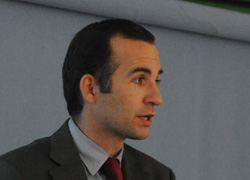IMDEA Networks

Event Category: In-house Presentation
A Control Theoretic Approach to Distributed Optimal Configuration of 802.11 WLANs
The optimal configuration of the contention parameters of a WLAN depends on the network conditions in terms of number of stations and the traffic they generate. Following this observation, a considerable effort in the literature has been devoted to the design of distributed algorithms that optimally configure the WLAN parameters based on current conditions. In this work we propose a novel algorithm that, in contrast to previous proposals which are mostly based on heuristics, is sustained by mathematical foundations from multivariable control theory. A key advantage of the algorithm over existing approaches is that it is compliant with the 802.11 standard and can be implemented with current wireless cards without introducing any changes into the hardware or firmware. We study the performance of our proposal by means of theoretical analysis, simulations and a real implementation. Results show that the algorithm substantially outperforms previous approaches in terms of throughput and delay.
Read more arrow_right_altWhen the network follows the mobile: extensions to Proxy Mobile IPv6
Users' demands for Internet connectivity anytime anywhere are no longer a future requirement, but a reality that operators face today. The current trend in hand-held devices, equipped with multiple access technologies, and accessing IP data services triggered the need for mobility support managed by the IP layer. However, the complexity of protocols such as Mobile IP complicated the deployment of solutions in real products. Lately, there is a new trend toward solutions that enable the mobility of IP devices with a local domain with only the support from the network. Proxy Mobile IPv6 is the solution standardized by the IETF that follows this "novel" approach.
Read more arrow_right_altImpact of Prefix Hijacking on Payments of Providers
Whereas prefix hijacking is usually examined from security perspectives, this paper looks at it from a novel economic angle. Our study stems from an observation that a transit AS (Autonomous System) has a financial interest in attracting extra traffic to the links with its customers. Based on real data about the actual hijacking incident in the Internet, we conduct simulations in the real AS-level Internet topology with synthetic demands for the hijacked traffic. Then, we measure traffic on all inter-AS links and compute the payments of all providers. The analysis of our results from technical, business, and legal viewpoints suggests that hijacking-based traffic attraction is a viable strategy that can create a fertile ground for tussles between providers. In particular, giant top-tier providers appear to have the strongest financial incentives to hijack popular prefixes and then deliver the intercepted traffic to the proper destinations. We also discuss directions for future research in the area of hijacking-based traffic attraction.
Read more arrow_right_altI-seismograph: Observing and Measuring Internet Earthquakes
Disruptive events such as large-scale power outages, undersea cable cuts, or Internet worms could cause the Internet to deviate from its normal state of operation. This deviation from normalcy is what we call the impact on the Internet, which we also refer to as an "Internet earthquake."
Read more arrow_right_alt
Is Content Publishing in BitTorrent Altruistic or Profit-Driven?
BitTorrent is the most popular P2P content delivery appli-cation where individual users share various type of content with tens of thousands of other users. The growing popular-ity of BitTorrent is primarily due to the availability of valuable content without any cost for the consumers. However, apart from required resources, publishing (sharing) valuable (and often copyrighted) content has serious legal implica-tions for users who publish the material (or publishers). This raises a question that whether (at least major) content publishers behave in an altruistic fashion or have other incentives such as financial. In this study, we identify the content publishers of more than 55K torrents in two major BitTorrent portals and examine their behavior. We demonstrate that a small fraction of publishers is responsible for 67% of the published content and 75% of the downloads. Our investigations reveal that these major publishers respond to two dif-ferent profiles. On the one hand, antipiracy agencies and ma-licious publishers publish a large amount of fake files to protect copyrighted content and spread malware respectively. On the other hand, content publishing in BitTorrent is largely driven by companies with financial incentives. Therefore, if these companies lose their interest or are unable to publish content, BitTorrent traffic/portals may disappear or at least their associated traffic will be significantly reduced.
Read more arrow_right_altVivisecting the YouTube Video Delivery Cloud: Overall Architecture and Key Mechanisms
Since its inception in 2005, YouTube has seen explosive growth in its popularity; today it is indisputably the world’s largest video sharing site. Given the number of viewers and the accompanying traffic volume, its geographical span and scale of operations, the design of YouTube’s content delivery infrastructure is a highly challenging engineering task.
Read more arrow_right_altContent-Centric Networking: challenges and (possible) solutions
Content-Centric Networking (CCN) is a clean-slate proposal to replace/enrich the current Internet. CCN is focused on content instead of machines, so users can request a given content by sending Interest messages with the name of the content. CCN routers have three main data structures: a FIB mapping content names to outbound faces, a Content Store to cache data packets and a pending Interest table (PIT) to forward incoming packets towards the consumers, using a breadcrumb mechanism. Security is part of the proposal, as all data packets are signed by its publisher.
Read more arrow_right_altFrom intelligent transportation to smart grid. In quest of the killer application for multiagent system technology
Since the early nineties, intelligent agents and multiagent systems have been envisioned as the key enabling technologies for the design and implementation of large-scale, open, distributed systems. After two decades, the scientific community is still in quest of the killer application that could unleash the full potential of multiagent systems. In recent years, smart infrastructures, such as intelligent transportation and smart power networks, attracted the interest of the scientific community as two paradigmatic large-scale, open, distributed systems of a great social and economical relevance. In particular the talk will focus on two examples of on-going research on the application of market-based methods for the efficient allocation of urban road networks and coalition formation for the creation of virtual power plants.
Read more arrow_right_altRouting and Scheduling for Power and Delay Minimization in the Powerdown Mode
Energy conservation is drawing increasing attention in data networking. One school of thought believes that a dominant amount of energy saving comes from turning off network elements. The difficulty is that transitioning between the active and sleeping modes consumes considerable energy and time. This results in an obvious trade-off between saving energy and provisioning performance guarantees such as end-to-end delays.
Read more arrow_right_altShort guidelines for writing scientific papers
Arturo Azcorra will present what are, on his personal experience, best practices for writing a technical paper. The talk will cover some ideas to follow, and some issues to avoid, when writing a paper.
Read more arrow_right_alt











Recent Comments